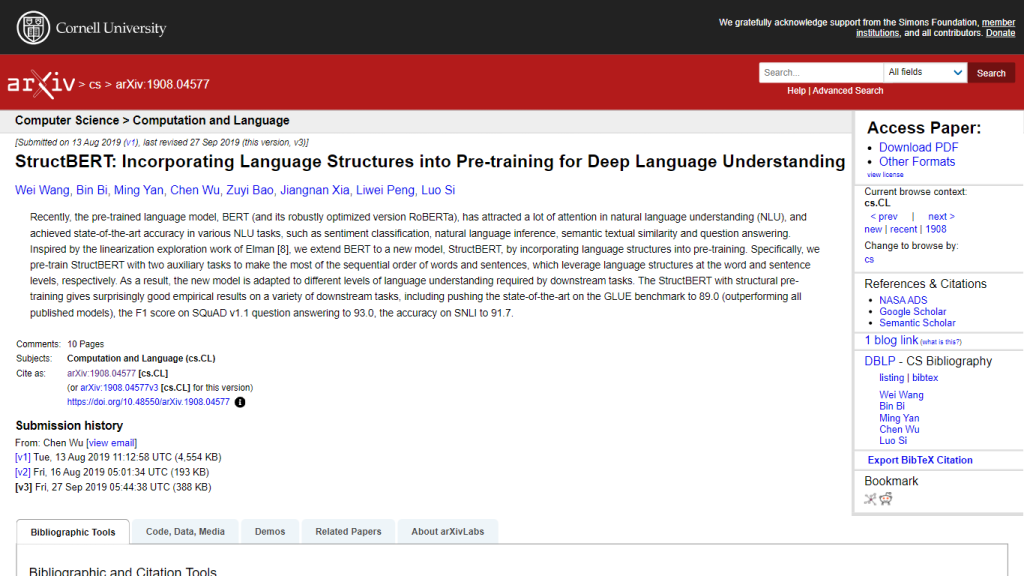What is StructBERT?
StructBERT is the new extension to the BERT language model that puts in efforts to uplift Natural Language Understanding by getting linguistic structures baked into its pre-training essence. It records very good results in most of the NLU tasks due to two auxiliary tasks being proposed that squeeze the sequential order of words and sentences. Inherent in this model, because of it embedding the structural properties of a language, StructBERT gets tuned to comprehend these various levels of nuances in a language, something that reflects in its superior performance on benchmarks.
Key Features & Benefits of StructBERT
-
Enhanced Pre-training:
Adds language structures into BERT’s pre-training process for enhanced NLU. -
Auxiliary Tasks:
It has two auxiliary tasks that enable exploitation of the orders of words and sentences to understand the language better. -
State-of-the-Art Performance:
with record scores on GLUE benchmark, SQuAD v1.1, and evaluations SNLI. -
Adaptability:
Specifically adapted to meet the different needs of language understanding in downstream tasks. -
Robust Optimization:
Improve upon the robustly optimized form of BERT, which is termed RoBERTa, by getting better accuracy.
Use Cases and Applications of StructBERT
It does well on most NLU tasks such as:
- Sentiment Classification
- Natural Language Inference
- Semantic Textual Similarity
- Question Answering
It finds a wide range of applications starting from customer service to healthcare and financial industries where advanced language understanding is needed.
For example, StructBERT could be applied in customer service for a better understanding of customer queries to chatbots for appropriate replies. Similarly, it might be employed in analyzing patient records for deriving meaningful insights in the healthcare sector or for better sentiment analysis in the financial sector in predicting markets.
How to Use StructBERT
StructBERT is based on the following steps:
-
Data Preparation:
Arrange the huge text data for your task. -
Model Selection:
Choose a particular variant of the StructBERT model for your problem. -
Training:
This dataset fine-tunes the model. -
Evaluation:
The model performance is validated on proper metrics. -
Deployment:
The model is integrated into your software for real-world usage. Some good practices include the facts that the dataset must be clean and balanced and that periodically refreshing the model with new data is good in order to retain the accuracy of the model.
How StructBERT Works
It leverages the structural properties of language with the help of the following two additional auxiliary tasks:
-
Word Order Task:
This helps the model get a better grasp over the placement of a word in a sentence. -
Sentence Order Task:
Sentences in text can be interleaved, so this technique understands the order of a sentence given in a text.
The model is architected based on RoBERTa for robust optimization technologies to have high accuracy and performance. These structural elements enable the better understanding of subtle language and generation in StructBERT.
StructBERT Pros and Cons
Here are the pros of StructBERT:
- Understands language better.
- Offers top performance on standard benchmarks.
- Can be fine-tuned for a plethora of NLU tasks.
And here are the cons:
- Training is computation-expensive.
- It needs lots of application-to-application fine-tuning.
User feedback generally showers praise on the model for exactness and versatility but raises reservations on its resource-intensive nature.
Conclusion concerning StructBERT
StructBERT is an enhanced version of the BERT model in which linguistic structure is saturated into pre-training in order to provide enhanced natural language understanding. Benchmarks by the laboratory indicate better performance, and it can easily adapt to many NLU tasks, therefore gaining applications in many industries, from customer care to finance. This, however, comes at a significant computational cost, though often the advantages outweigh the costs.
Future developments and updates will undoubtedly push StructBERT further into its status as a must-have in the field of natural language processing.
StructBERT FAQs
-
What is StructBERT?
StructBERT is a BERT-based model designed to introduce language structures into the pre-training process to improve scalable deep language understanding for different NLU tasks. -
On what type of NLU tasks have excellent results been reported by StructBERT?
StructBERT has achieved superior numbers in sentiment classification, natural language interference, semantic textual similarity, and question-answering tasks. -
How does StructBERT make use of language structures?
StructBERT takes advantage of language structures using two auxiliary tasks that model both the sequential sequence of words and sentences at both the word and sentence levels. -
What are the scores of StructBERT benchmarks?
StructBERT also attained new state-of-the-art results on various benchmarks, including an 89.0 GLUE score, 93.0 F1 score on SQuAD v1.1, and 91.7 SNLI accuracy. -
Authors of Structured-BERT:
StructBERT is designed by Wei Wang, Bin Bi, Ming Yan, Chen Wu, Zuyi Bao, Jiangnan Xia, Liwei Peng, and Luo Si.










